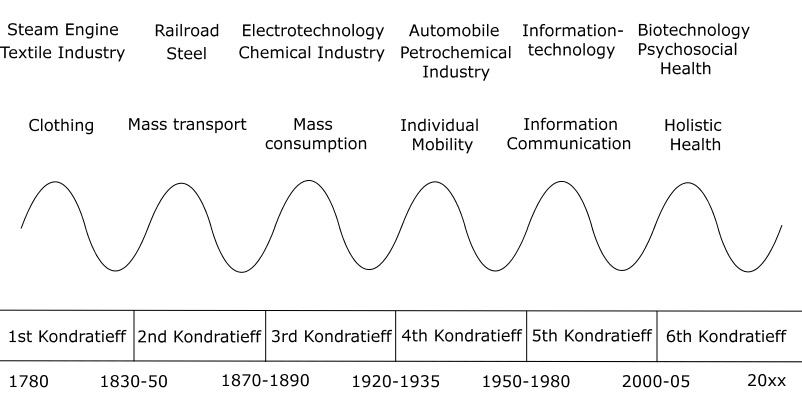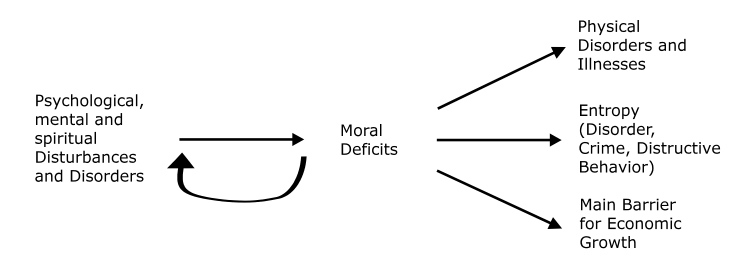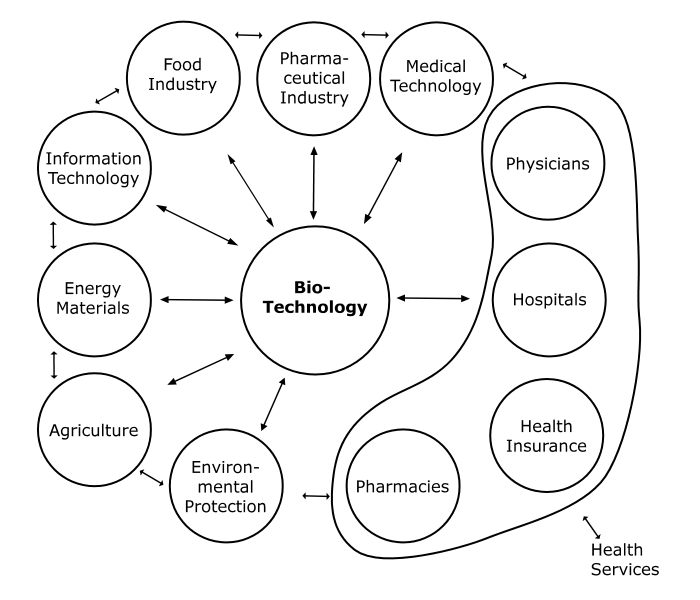The Sixth Kondratieff – The New Long Wave of the Global Economy
Almanac: Kondratieff waves:Cycles, Crises, and Forecasts
The first time I encountered the name of Nikolai Kondratieff was in the mid-1980s. At that time, I came across the book Stalemate in Technology (German title Der technologische Patt) by Gerhard Mensch. I was very impressed and began to learn about the Theory of Long Waves. After a short time, it became clear to me that one could understand the structural change in the post-war years easier with the help of the Kondratieff cycles. This is how my book ‘The Fifth Kondratieff’ came to be in the early 1990s.
Another insight I had gained from working on the fifth Kondratieff was that this cycle had already reached a level of maturity – its beginning dates back to the early 1950s. It was already forty years into it and would have to end in approximately 10–15 years based on the Kondratieff Theory. And so I asked myself the question: what comes after this? What or who is going to be the carrier of the new, sixth Kondratieff? Can you actually do this – predict a Kondratieff cycle?
And so I began to search for the sixth Kondratieff. The focus was on the search for its carriers, the new basic innovations. To identify them, you have to look for them on four levels: on the technological, economic, societal and on the time level. The carriers of the sixth Kondratieff must have a life cycle of 40–60 years. You can find a detailed description of these four criteria in Nefiodow and Nefiodow 2014.
In addition, the major barriers to growth had to be identified. This was the most difficult and important challenge for the prediction. Here I was surprised to find out that the most important barriers to developing the sixth Kondratieff no longer laid in the technological area, but instead with the human being.
The first edition of my book The Sixth Kondratieff was published in 1996. The assumption back then was that the sixth Kondratieff would be a health-related cycle. Back then, this was still just pure prediction, since the sixth Kondratieff was in its embryonic stage at that time. Today one can say that the sixth Kondratieff is a health-related cycle (see Fig. 1). Outside of the health care sector, there is currently no other candidate through which industrial nations would be able to achieve a sustainable upswing and full employment.
Barrier No. 1: Worldwide Social Entropy
The largest barrier to developing the sixth Kondratieff cycle is global disorder, entropy. Entropy is a term taken from physics that describes the disorder of a physical system. Here the term is used to demonstrate the global societal disorder.

Fig. 1. The six long waves of economic development
Source: Nefiodow and Nefiodow 2014.
Disorder has become a worldwide mega problem and a mega destructive market. Worldwide money laundering has increased twentyfold from 1990 until 2009 and had almost reached US$ 2,000 billion. Corruption and bribery are at a record high all over the world and in 2013 caused at least five percent of all economic costs (US$ 4,000 billion). Patent protection and copyrights are systematically being ignored or evaded. Piracy on the world's oceans is increasing. Cyber crime is growing by double-digits, computer virus attacks and counterattacks are increasing and have led to a new type of warfare, so-called cyber warfare between companies, institutions and countries. Millions of people all over the world work for illegal organizations. This list could go on and on.
If we add up the damages, losses and costs that accumulate every year from disorder, we get an amount of at least US$ 18,000 billion for the year 2014. That was much more than the United States gross national product.
The entropic sector plays a key role in the economy, because the enormous losses, damages and costs that incur year after year in this instance have turned this into the most significant barrier for the economic and societal development.
Entropy and Health
What are the causes of global disorder? They are moral deficits. But these deficits can also be viewed from a different perspective. Moral deficits can be seen as health deficits (see Fig. 2).
This becomes apparent if you draw a comparison with the behavior of healthy people. A psychologically healthy person does not cheat. A mentally healthy person does not use drugs. A socially healthy person has a sense of community, advocates well-being of all people and does not harass others. A spiritually healthy person has a trusting relationship with God, strives for reconciliation, truth and peace and does not spread hatred and violence. Inner disturbances and diseases and the social misconduct caused by them are the deeper reasons for global entropy (see Fig. 2).

Fig. 2. The relationship between moral deficits – entropy – inner health
Source: Nefiodow and Nefiodow 2014.
At this point, I would like to elaborate on the term ‘health’.
The WHO (World Health Organization) definition of health is a state of complete physical, mental and social well-being and not merely the absence of disease or infirmity. In 1997, the Executive Board of the World Health Organization (WHO) provided some food for thought with a broader definition of health: ‘Health is a dynamic state of complete physical, mental, social and spiritual well-being and not merely the absence of disease or infirmity’. This was once again highlighted in the 2005 Bangkok Charter for Health Promotion in a Globalized World, ‘Health is one of the fundamental rights of every human being and encompasses mental and spiritual well-being’.
According to the WHO, terms like ‘disease’ and ‘health’ should not be limited to the body. They are systems concepts. There are also sick souls, sick families, companies and societies.
Aside from the entropic sector, there is a second barrier to sustainable growth: the traditional health care sector.
The Traditional Health Care Sector
Over the past two centuries, the traditional health care sector made tremendous progress. The history of medicine over the past two centuries was a real success story.
The traditional healthcare system
• Medical technology;
• Pharmaceutical industry;
• Health services (doctors, non-medical practitioners, hospitals, health insurance companies, health insurance funds, pharmacists, public health services, medical care facilities);
• Health spas/sanatoriums;
• Company health services (health as a competitive factor, training and continuing education (e.g., in people skills), human resource development, health management;
• Other (health-related) (skilled trades, e.g., for orthopedic products, sporting goods and sports facilities, health publications, medical EDP, etc. see Nefiodow and Nefiodow 2014).
But this success story is about to end. Since the late 20th century, the new medical advances are no longer sufficient to adequately deal with the dynamics and complexity of modern life and its high demands on the physical, emotion- nal and mental strength of human beings.
The biggest problem of the traditional health care sector is a level of productivity which is too low. Productivity is too low because the costs caused by medical advances are not being counterbalanced by the cost reduction they create (Schneider et al.1992). Another problem is the fact that the traditional health care sector is not geared towards healing, but primarily towards the treatment of disease symptoms, for example, dementia. In 2010, the U.S. federal health insurance programs Medicare and Medicaid spent approximately US$ 140 billion to treat dementia, but only US$ 0.5 billion to research its causes. A ratio of 280:1.
As a result of this low productivity and the one-sided bias towards physical disease, costs continue to increase. Meanwhile, global health expenditures are at US$ 12,000 billion.
We have now identified the two primary barriers. If the traditional health-care system is removed as a carrier, then who are the stakeholders that are going to shape the sixth Kondratieff?
The Newly Emerging Second Health Care Sector
One of the most important new stakeholders is biotechnology (Fig. 3). It is not just a brand-new technology, it is one of the new basic innovations of the sixth Kondratieff because it will improve the productivity in handling physical diseases, it will reduce costs significantly and it will improve our competence in avoiding diseases and our competence in healing.

Fig. 3. The biotechnology value chain
Source: Nefiodow and Nefiodow 2014.
The newly emerging healthcare sector
• Biotechnology;
• Naturopathic treatments, natural products, all natural foods;
• Complementary/alternative medicine (homeopathy, classic acupuncture, electroacupuncture according to Dr. Voll, kinesiology, bioresonance therapy, anthroposophic medicine, magnetotherapy, Dr. Rath's cellular medicine, biofeedback, quantum healing, traditional Chinese medicine, ayurvedic medicine, Reiki, etc.);
• Environmental protection (predominantly);
• Agriculture, diet, food;
• Wellness/fitness, tourism (health tourism);
• Architecture (healthy living), building and construction industry (healthy building materials), textile industry (allergy-free and breathable textiles and clothing), the senses (color therapies, aromatherapies, music therapies);
• Self-medication and self-care (participation of illness costs, rising self-care);
• Workplace health management (company health insurance funds, company sponsored fitness programs, cafeterias, welfare centers, health seminars, preventive medical checkups, good health bonus);
• Psychology, psychiatry, psychotherapy, psychosomatic medicine;
• Religion/spirituality.
The second basic innovation of the sixth Kondratieff is psychosocial health. Psychosocial healing of human is the most efficient tool to control global entropy. There is still a significant need for research in this area, because there are currently still large theoretical deficits in understanding mental and psychological disorders.
Another protagonist in the new, emerging health care sector is spirituality/religion. Many studies prove that religious beliefs have a healing effect on the body, soul and spirit. Raphael Bonelli of the University of Vienna and Harold Koenig of Duke University in the USA have analyzed all studies on the link between health and religion published between 1990 and 2010, and concluded that in 74 percent of the studies. There is a positive correlation between Christian faith and health.
The Strengths of the Kondratieff Theory
How can we classify the status of the Kondratieff Theory within the scope of global economic and social sciences today?
The biggest benefit of thinking in periodic business cycles is the fact that we are thereby able to link macroeconomic thinking with the level of innovation and technology. This makes it possible to correlate thinking in periodic cycles – Kitchin cycles, Juglar cycles, Kuznets and Kondratieff cycles – as represented by the Kondratieff Theory, with the real economy.
Another benefit is that ethical, social and cultural needs can be integrated into the framework of the Kondratieff Theory. The fact that ethics and global social justice should play a larger role in the global economy is not a new request, but at the beginning of the 21st century and against the backdrop of escalating global problems, is now becoming a challenge that can no longer be ignored.
Thinking in periodic business cycles makes it possible to provide solid foresights. If politics are not meant to remain forever reduced to mere reaction and crisis management, economic policy then needs to gain foresight. Foresight is not to be confused with predictions or visions. Foresight is based on hard facts and its application based on a proven and tested theory. In the information society, it is possible to monitor and quantify the market processes more precisely than in the industrial society, since the necessary information can be collected at reasonable cost and analyzed with powerful computers.
Final remarks
We explained that the sixth Kondratieff is a health-related cycle. To achieve a strong upswing, the health care sector needs to be geared towards the demands of the 21st century and expanded to the human being as a whole. This means that for the first time in history, the focus of economic and societal development is not on a machine, a chemical process or hardware technology, but rather the human being with his physical, mental, social, ecological and spiritual needs, problems and potential. We leave the growth patterns of previous Kondratieff cycles behind. Now the human being takes the center stage. This is the message of the sixth Kondratieff: the healing of human is the best program for the future.
References
Nefiodow L., and Nefiodow S. 2014. The Sixth Kondratieff. The New Long Wave of the Global Economy. Amazon.
Schneider M., Dennerlein R., Köse A., Scholtes L. 1992. Health Care in the EC Member States. Health Policy 20 (1–2): 1–251.
